________________________________________________________
McGizmo HD45
________________________________________________________
What is this light?
The HD45 is a stand-alone light intended for heavy duty use and abuse, and it follows the KISS-principle (keep it super simple) like few other lights do. It won't fit into the modular Aleph-Series nor will it interchange parts with the McLuxIII-PD.
There are no bells and whistles built in the HD45, but it is a very rugged and strong performer.
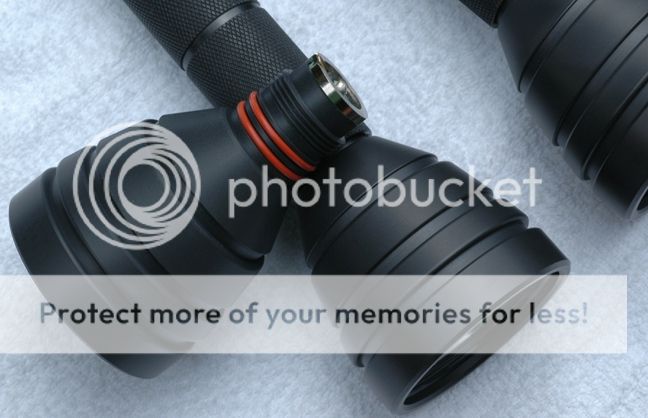
The Construction
Made of T6061 aluminium and sporting a HAIII surface in the McGizmo-typical "dark slate gray"-finish (almost black) it comes with the usual high build quality. The body is fully knurled for better grip and has a deep groove at the end of the light to accomodate a lanyard if desired.
The light was designed with the intent for it to be able to go underwater and survive compression loads from submersion. It is not officially labeled as a dive light nor is it suggested to be used as such. There are two possible points of entry for water and they are through the front of the head and through the head to battery tube joint. The front of the light is guarded with a 4.6 mm thick polycarbonate window which seats against a face seal O-ring. The window is retained by an additional O-ring that seats in a groove and puts a compression load against the window to provide the initial seal. Additional external pressure will force the window further against its seal. The window sports an abrasion resistant coating. The battery tube seal consits of two bore seal O-rings located on the head and forward of the male threads. Both O-ring seals are engaged in both off and on postitions.
The Head has a major OD of 55 mm or 2-5/32". It hosts a 45 mm reflector based on the same reflective curve as the McR-27 and McR-38. The reflector has an OD of 45 mm and is 44 mm deep. The LED is mounted in a pocket in an integral bulkhead so the head is the heat sink. The mass of the reflector is also in the thermal path to a reasonable extent.
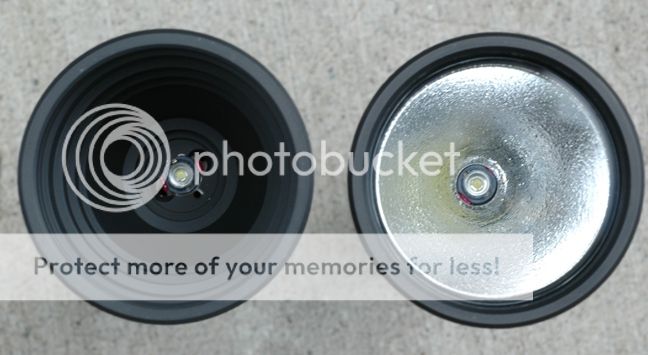
The battery tube is approximately 25 mm or 1" in OD. It has a battery bore ID of .740" or 18.8 mm. This bore will allow the overly fat Pila 168A to be digested. The light will also work with 2xCR123's and 18650 or 17650 cells. There is a silver plated conical ground spring in the bottom of the tube that makes contact with the rear face that has been faced after anodize to expose the raw Al.The switching is accomplished first by Killroy's nose and for high level, when the contact ring makes contact with the shoulder in the battery bore. The contact ring is only .750" in OD so there is a .010" interference of overlap between the contact ring and its contact surface.
The contact area of the killroy and contact ring with the shoulder in the battery tube is not a large surface area. In many of the lights, Killroy breaks in by forming a channel into the counterbore shoulder and you can see what looks to be almost the start of a thread in the battery tube. During the break in time, you will find some evidence of Al in the grease and may need to clean Kilroy's nose on ocassion.
How it works
The light is a simple head-twisty ... you tighten the head and first get low-mode and upon further tightening you'll encounter high mode. It is quite similar to the constant-on modes of the McLuxIII-PD.
That's all you'll need to know about operating this KISS light.
To replace the batteries screw off the head and drop in the batteries of your choice, positive terminal facing the head.
What about the driver, LED and batteries?
The HD45 uses the Wiz2x2 driver (LuxIII version) which accepts Vin up to 6V and has a cut-off at about 2.5V ... meaning either 2xCR123 or 1xLi-Ion is possible. Due to the large battery tube you can use the PILA168S, PILA 168A, 18650 and 17650 cells. Do not use 2xR123 except the 3V-versions!!
The low level is regulated at 150mA whereas the high level boasts 950mA to the LED, fully current regulated for both of them.
The anode bead used in these sets the positive contact plane above the contact ring and Killroy. This was intentional to allow for the cells that have large diameter and shallow anode contacts. That's the good news. The bad news is that the polarity protection is dubious at best and non existant for any of the rechargeables. Additionally make certain that if a narrow cell that can go off center does not have an anode contact that is either dented in or so conformed that it could inadvertantly contact the cathode contact ring or Killroy. This should not be posible with what I have seen of the batteries but I don't want anyone messing with a cell that could possibly short in there!!!!! The interior of the contact ring where the PCB is and the LED solder points as well as Killroy's legs can be covered with a tape, mylar or even thin foam if there is any concern about unwanted contacts!!!!!!!
Runtimes are those:
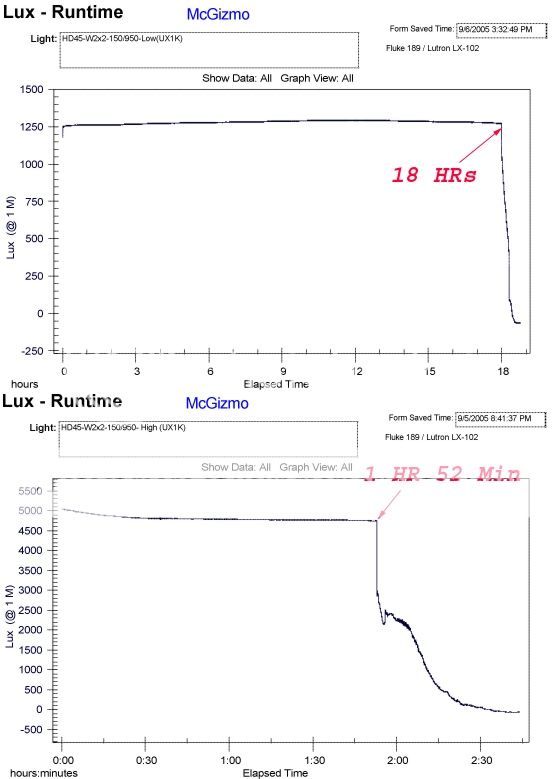
Numbers in those charts are actual lux-readings. A straight 18 hours of 1200 lux off 2xCR123's is not too shabby!
According to Lurveleven the runtime on high with one of AW's protected 2200mAh 18650 cells was 113min while a PILA168A with 2000mAh went for 112min. YMMV.
The current generation of HD45 lights is offered with an updated version of the DownBoy driver with the same two regulated levels of light, but now you can use 2 x R123 in addition to the usual 2 x CR123 or 1 x Li-Ion ... but the light might enter direct drive sooner on a single Li-Ion.
Attachment options
You can add a lanyard in the groove described above, and apart from that there are no explicit attachment options for this light in the stock version nor is there a specific holster.
However, due to the generous dimensions and wall thickness, a few options may present themselves:
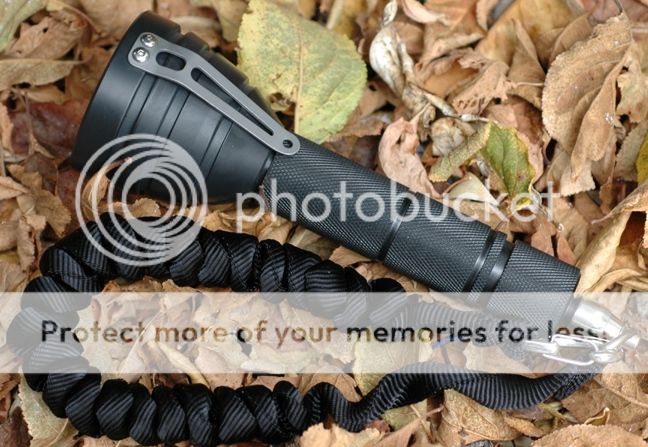
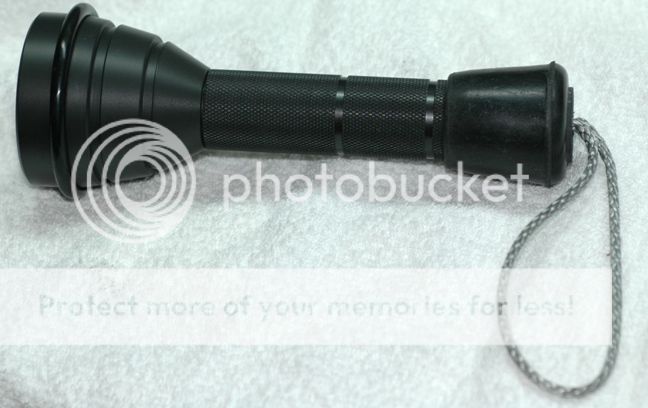
Size comparison
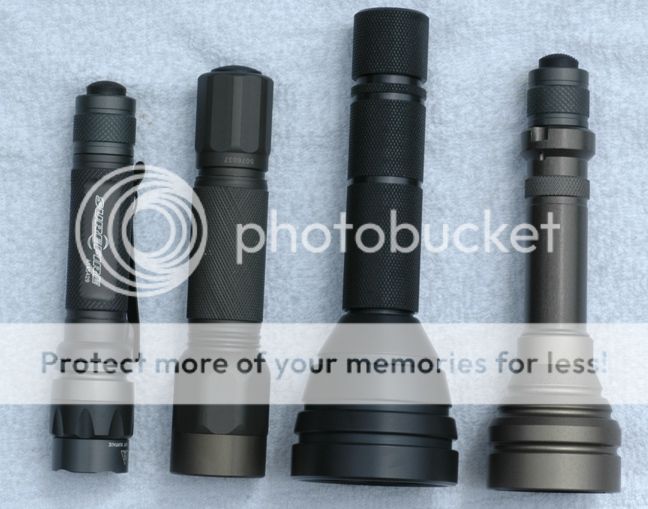
What it does
It makes light. In a special way. The huge McR-45 reflector that has the same curve as the venerable McR-27 (aka PR) collects a lot more of the corona-light and redirects it into a more concentrated beam, resulting in a very tight, concentrated and bright corona that throws amazingly well and enlarges as well as softens the needle-like hotspot of the 27mm reflector.
Due to the very aggressive orange peel we get a very smooth transition from spot to corona and a very nice beam quality, but don't gain a lot in lux/throw when compared to the McR-38 in the Aleph3, another brother with the same curve.
Here's the white-wall shot:
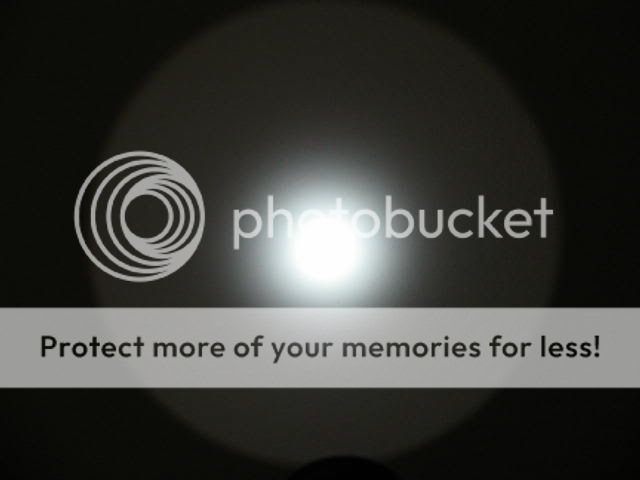
And two shots (different exposures) vs. a 27mm light powered at 1000mA (CAVEAT Luxeon lottery):
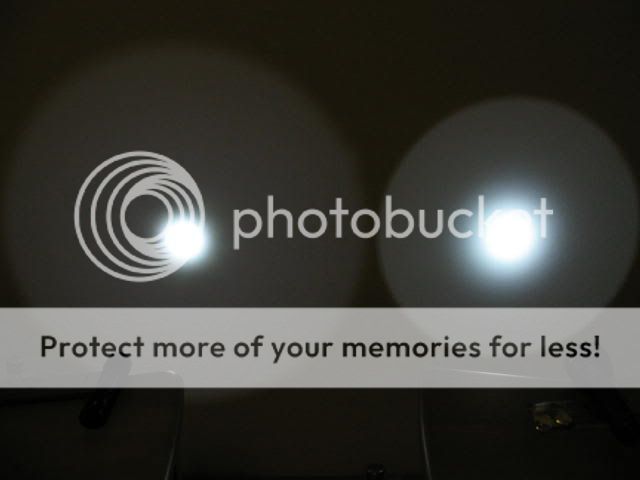
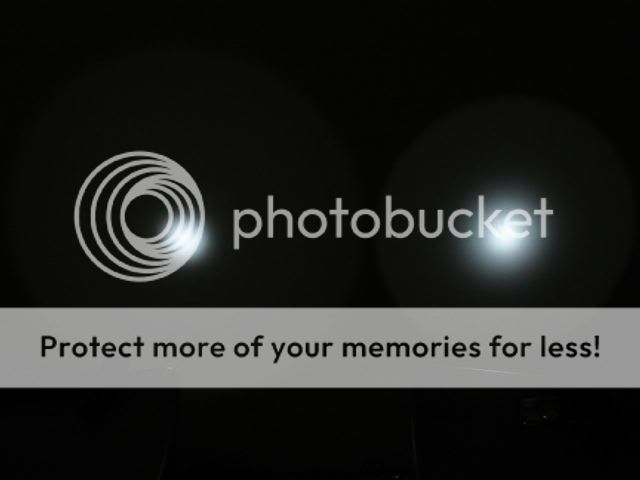
The real-life shots look like this:
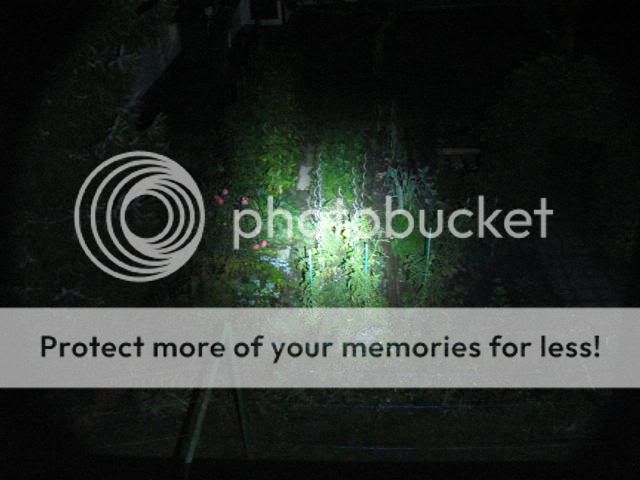
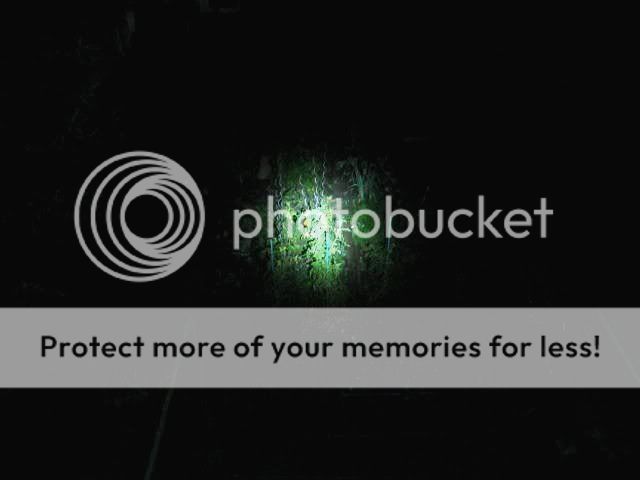
Note that the corona of the 27mm light is too weak to really show in the pic and is almost useless due to the high contrast with the needle-like spot, whereas the HD45 has a brighter and larger spot as well as a very useful corona. This corona is smaller than the one of the 27mm however ... the edges can be guessed in the outer rims of the pic.
On 150 mA, this light will register lux readings in excess of many smaller lights on their high setting. It is quite possible to navigate and illuminate targets at a reasonable distance on the low level and it should be expected that the light would be used often in low. On high, there is plenty light to break into ambient shadow or reach good distances in the dark.
Shots with HD45 UX1K (Joker) on high and low including corona, a HD45 WX1S on high and low and an Aleph1 TW0K at 1000mA as well as SF U2 for comparison:
HD45 UX1K-Joker:
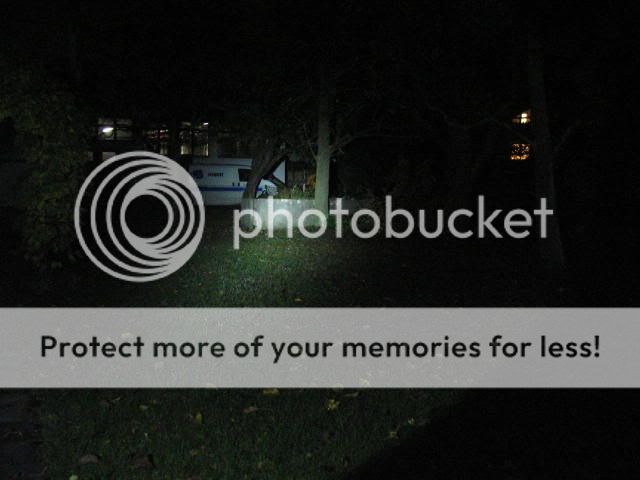
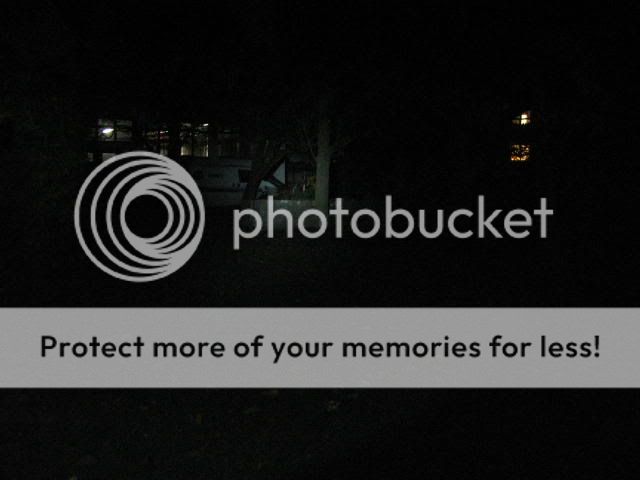
HD45 WX1S:
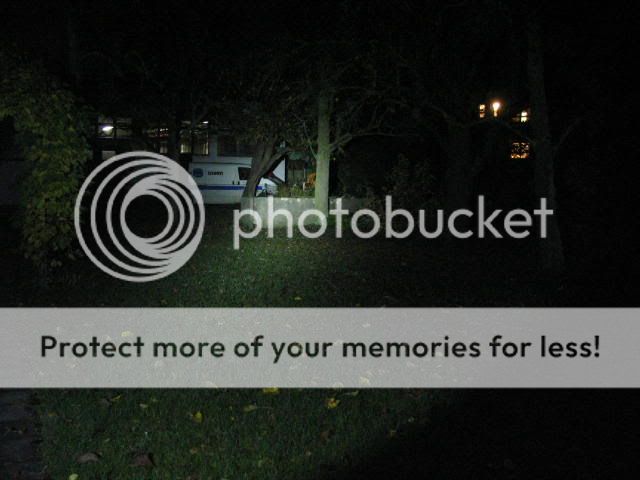
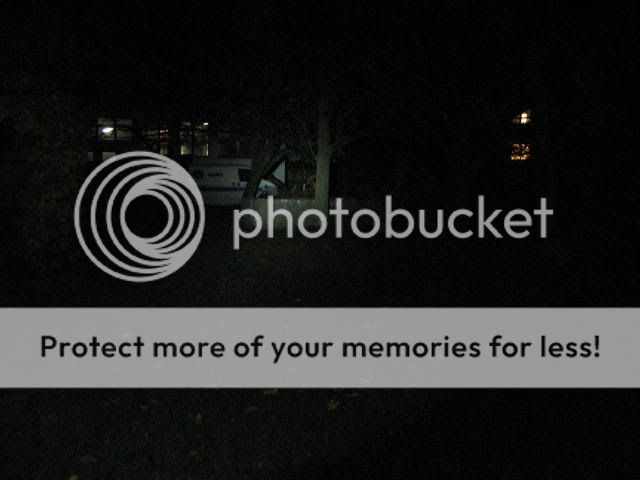
Aleph1 TW0K 1000mA:
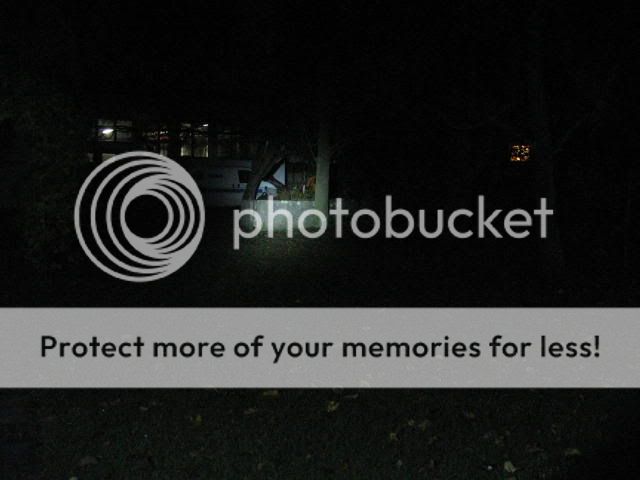
SF U2:
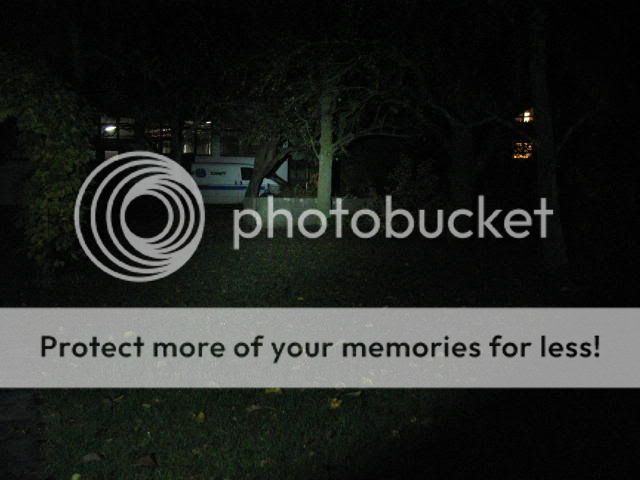
So ... with the HD45 you get a very bright and concentrated corona that is quite useful in ranges where the coronas of other lights have already vanished in the dark. This is especially true for the low-mode that benefits from a very usable corona. You'll also get a bigger and smoother hotspot that can illuminate more terrain than say a 27mm light at the same power.
However ... you won't get much more throw than with the 38mm reflector in the Aleph3. If you want significantly more throw than your Aleph3 can offer ... this light is not for you. Of course it will outthrow any 27mm light and humiliate it at same drive levels :devil: .
 Please note that these shots were taken with a "Joker" LuxIII UX1K of the first run HD45 lights. Should you get a standard non-Joker LED your hotspot will be hotter and less diffused than with this version
Please note that these shots were taken with a "Joker" LuxIII UX1K of the first run HD45 lights. Should you get a standard non-Joker LED your hotspot will be hotter and less diffused than with this version 
What about a LuxV-Version?
YES!
It is here and available .... finally! Drive current is normally 700/150 mA.
Any custom versions?
No. And as usual ... don't ask. Don is unfortunately not able to work more than 24/24h although he is trying hard
Summary
The HD45 is a KISS heavy-duty light with two regulated light levels that is built like a tank. It offers a very concentrated beam with a bright corona and a big, soft and yet well-throwing hotspot and boasts impressive runtimes. A variety of batteries can be used, especially those fat Li-Ion cells.
Following this design philosophy also means that the unit does not have any bells and whistles ... meaning no clicky-tailcap, no glass window but the unbreakable lexan (with less light transmittence), no fancy clip etc.
This one isn't a collector's item of beauty and complexity, it is a tough tool that can take some abuse and delivers what it promises at the front end.
bernhard
McGizmo HD45
________________________________________________________
What is this light?
The HD45 is a stand-alone light intended for heavy duty use and abuse, and it follows the KISS-principle (keep it super simple) like few other lights do. It won't fit into the modular Aleph-Series nor will it interchange parts with the McLuxIII-PD.
There are no bells and whistles built in the HD45, but it is a very rugged and strong performer.

The Construction
Made of T6061 aluminium and sporting a HAIII surface in the McGizmo-typical "dark slate gray"-finish (almost black) it comes with the usual high build quality. The body is fully knurled for better grip and has a deep groove at the end of the light to accomodate a lanyard if desired.
The light was designed with the intent for it to be able to go underwater and survive compression loads from submersion. It is not officially labeled as a dive light nor is it suggested to be used as such. There are two possible points of entry for water and they are through the front of the head and through the head to battery tube joint. The front of the light is guarded with a 4.6 mm thick polycarbonate window which seats against a face seal O-ring. The window is retained by an additional O-ring that seats in a groove and puts a compression load against the window to provide the initial seal. Additional external pressure will force the window further against its seal. The window sports an abrasion resistant coating. The battery tube seal consits of two bore seal O-rings located on the head and forward of the male threads. Both O-ring seals are engaged in both off and on postitions.
The Head has a major OD of 55 mm or 2-5/32". It hosts a 45 mm reflector based on the same reflective curve as the McR-27 and McR-38. The reflector has an OD of 45 mm and is 44 mm deep. The LED is mounted in a pocket in an integral bulkhead so the head is the heat sink. The mass of the reflector is also in the thermal path to a reasonable extent.

The battery tube is approximately 25 mm or 1" in OD. It has a battery bore ID of .740" or 18.8 mm. This bore will allow the overly fat Pila 168A to be digested. The light will also work with 2xCR123's and 18650 or 17650 cells. There is a silver plated conical ground spring in the bottom of the tube that makes contact with the rear face that has been faced after anodize to expose the raw Al.The switching is accomplished first by Killroy's nose and for high level, when the contact ring makes contact with the shoulder in the battery bore. The contact ring is only .750" in OD so there is a .010" interference of overlap between the contact ring and its contact surface.
The contact area of the killroy and contact ring with the shoulder in the battery tube is not a large surface area. In many of the lights, Killroy breaks in by forming a channel into the counterbore shoulder and you can see what looks to be almost the start of a thread in the battery tube. During the break in time, you will find some evidence of Al in the grease and may need to clean Kilroy's nose on ocassion.
How it works
The light is a simple head-twisty ... you tighten the head and first get low-mode and upon further tightening you'll encounter high mode. It is quite similar to the constant-on modes of the McLuxIII-PD.
That's all you'll need to know about operating this KISS light.
To replace the batteries screw off the head and drop in the batteries of your choice, positive terminal facing the head.
What about the driver, LED and batteries?
The HD45 uses the Wiz2x2 driver (LuxIII version) which accepts Vin up to 6V and has a cut-off at about 2.5V ... meaning either 2xCR123 or 1xLi-Ion is possible. Due to the large battery tube you can use the PILA168S, PILA 168A, 18650 and 17650 cells. Do not use 2xR123 except the 3V-versions!!
The low level is regulated at 150mA whereas the high level boasts 950mA to the LED, fully current regulated for both of them.
The anode bead used in these sets the positive contact plane above the contact ring and Killroy. This was intentional to allow for the cells that have large diameter and shallow anode contacts. That's the good news. The bad news is that the polarity protection is dubious at best and non existant for any of the rechargeables. Additionally make certain that if a narrow cell that can go off center does not have an anode contact that is either dented in or so conformed that it could inadvertantly contact the cathode contact ring or Killroy. This should not be posible with what I have seen of the batteries but I don't want anyone messing with a cell that could possibly short in there!!!!! The interior of the contact ring where the PCB is and the LED solder points as well as Killroy's legs can be covered with a tape, mylar or even thin foam if there is any concern about unwanted contacts!!!!!!!
Runtimes are those:

Numbers in those charts are actual lux-readings. A straight 18 hours of 1200 lux off 2xCR123's is not too shabby!
According to Lurveleven the runtime on high with one of AW's protected 2200mAh 18650 cells was 113min while a PILA168A with 2000mAh went for 112min. YMMV.
The current generation of HD45 lights is offered with an updated version of the DownBoy driver with the same two regulated levels of light, but now you can use 2 x R123 in addition to the usual 2 x CR123 or 1 x Li-Ion ... but the light might enter direct drive sooner on a single Li-Ion.
Attachment options
You can add a lanyard in the groove described above, and apart from that there are no explicit attachment options for this light in the stock version nor is there a specific holster.
However, due to the generous dimensions and wall thickness, a few options may present themselves:


Size comparison

What it does
It makes light. In a special way. The huge McR-45 reflector that has the same curve as the venerable McR-27 (aka PR) collects a lot more of the corona-light and redirects it into a more concentrated beam, resulting in a very tight, concentrated and bright corona that throws amazingly well and enlarges as well as softens the needle-like hotspot of the 27mm reflector.
Due to the very aggressive orange peel we get a very smooth transition from spot to corona and a very nice beam quality, but don't gain a lot in lux/throw when compared to the McR-38 in the Aleph3, another brother with the same curve.
Here's the white-wall shot:

And two shots (different exposures) vs. a 27mm light powered at 1000mA (CAVEAT Luxeon lottery):


The real-life shots look like this:


Note that the corona of the 27mm light is too weak to really show in the pic and is almost useless due to the high contrast with the needle-like spot, whereas the HD45 has a brighter and larger spot as well as a very useful corona. This corona is smaller than the one of the 27mm however ... the edges can be guessed in the outer rims of the pic.
On 150 mA, this light will register lux readings in excess of many smaller lights on their high setting. It is quite possible to navigate and illuminate targets at a reasonable distance on the low level and it should be expected that the light would be used often in low. On high, there is plenty light to break into ambient shadow or reach good distances in the dark.
Shots with HD45 UX1K (Joker) on high and low including corona, a HD45 WX1S on high and low and an Aleph1 TW0K at 1000mA as well as SF U2 for comparison:
HD45 UX1K-Joker:


HD45 WX1S:


Aleph1 TW0K 1000mA:

SF U2:

So ... with the HD45 you get a very bright and concentrated corona that is quite useful in ranges where the coronas of other lights have already vanished in the dark. This is especially true for the low-mode that benefits from a very usable corona. You'll also get a bigger and smoother hotspot that can illuminate more terrain than say a 27mm light at the same power.
However ... you won't get much more throw than with the 38mm reflector in the Aleph3. If you want significantly more throw than your Aleph3 can offer ... this light is not for you. Of course it will outthrow any 27mm light and humiliate it at same drive levels :devil: .
 Please note that these shots were taken with a "Joker" LuxIII UX1K of the first run HD45 lights. Should you get a standard non-Joker LED your hotspot will be hotter and less diffused than with this version
Please note that these shots were taken with a "Joker" LuxIII UX1K of the first run HD45 lights. Should you get a standard non-Joker LED your hotspot will be hotter and less diffused than with this version 
What about a LuxV-Version?
YES!
It is here and available .... finally! Drive current is normally 700/150 mA.
Any custom versions?
No. And as usual ... don't ask. Don is unfortunately not able to work more than 24/24h although he is trying hard

Summary
The HD45 is a KISS heavy-duty light with two regulated light levels that is built like a tank. It offers a very concentrated beam with a bright corona and a big, soft and yet well-throwing hotspot and boasts impressive runtimes. A variety of batteries can be used, especially those fat Li-Ion cells.
Following this design philosophy also means that the unit does not have any bells and whistles ... meaning no clicky-tailcap, no glass window but the unbreakable lexan (with less light transmittence), no fancy clip etc.
This one isn't a collector's item of beauty and complexity, it is a tough tool that can take some abuse and delivers what it promises at the front end.
bernhard
Last edited:

